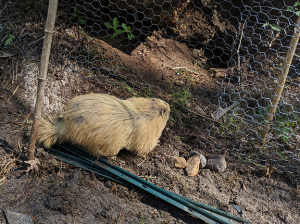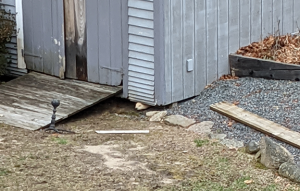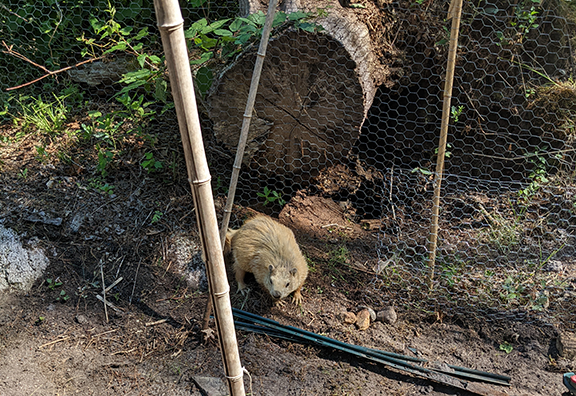BY JOHN H. HOUGH
 For years I’ve kept a garden, and around late July or early August, life would usually distract me from the endeavor. This year I was determined. July came, and my beans, cucumbers, peas, tomatoes, lettuce, peppers and broccoli were looking good. A $50 plastic greenhouse provided for an abundance of seedlings, except the tomatoes and herbs that I bought from the local nursery, not yet willing to try my luck with these tricky, and in my case maddening, seedlings.
For years I’ve kept a garden, and around late July or early August, life would usually distract me from the endeavor. This year I was determined. July came, and my beans, cucumbers, peas, tomatoes, lettuce, peppers and broccoli were looking good. A $50 plastic greenhouse provided for an abundance of seedlings, except the tomatoes and herbs that I bought from the local nursery, not yet willing to try my luck with these tricky, and in my case maddening, seedlings.
This success allowed for a great start to the 2022 edition of the garden. Helping me this year is my soon-to-be-four-year-old daughter, a fantastic watering can wielder and great, if somewhat distracted, company while plants are set in their places and seeds in the ground.
All this is to set the stage for the travesty that follows. A family garden, off to great start, on the verge of bearing fruit for all the labor. Then one afternoon while mowing the lawn I found an intruder had eaten everything except the tomatoes and eggplant. About 80 percent of the plant life in the garden eaten to the stem. I searched in vain for footprints and found none. This effectively ruled out the billions of deer that seemed to reside in the conservation land behind our house. Their weight would have left evidence of a hoof in the soil. The eight-foot garden fence had at least done its job in that respect, but clearly it let something in. Scat was scant, though admittedly not a subject I have studied to any extent whatsoever, so this would elucidate even had traces availed themselves.
 The mystery to me is the untouched tomatoes and eggplant. The prevailing theory, my only theory, is that these plants are members of the nightshade family and you don’t need to be a woodland critter to draw the conclusion.
The mystery to me is the untouched tomatoes and eggplant. The prevailing theory, my only theory, is that these plants are members of the nightshade family and you don’t need to be a woodland critter to draw the conclusion.
The base of the fencing was loose all around the garden, providing ample gaps for any number of small ground-dwelling mammals to intrude on the vegetable patch. I made some quick, slapdash upgrades to the garden defenses consisting of sinking chicken wire a few inches into the ground.
As evening descended, I ventured down the garden path and into the vegetable path when I came face to furry face with the culprit. Oddly blond and about 15 pounds, the woodchuck panicked and attempted to exit under the now-sunken fence. Failing that, he put his back to the chicken wire and began a standoff. His escape route, found impassable he froze a blond, inert, fearful tub of fur that once in a while would present an aggressive countenance and an attack posture; he looked as though he was ready for his last stand. Woodchucks are not known for their aggression, but this one looked like it would buck that trend. The flare of violent posturing disappeared as quickly as the little animal summoned it, and the critter went back to sitting as still as stone.
I thought my repairs, though quick in implementation, would have at least dissuaded the intruder from stealing crops. I figured the best way to see where I needed to improve was to have the woodchuck show me how he gained entry. With bamboo pole in hand, I gently nudged and herded the rodent around the fence as he sought egress. I’m not proud of chasing a small defenseless animal around the garden, but at least no one saw me; they’d probably still be laughing.
 He exited, and I took notes and planned to increase security. Days and many hours of toil later, I thought I’d turned a corner. New fencing, young bean plants and cucumbers just coming out of the parched soil. And he struck again with the same scorched-earth hunger.
He exited, and I took notes and planned to increase security. Days and many hours of toil later, I thought I’d turned a corner. New fencing, young bean plants and cucumbers just coming out of the parched soil. And he struck again with the same scorched-earth hunger.
It’s clear that we can no longer cohabitate with the woodchuck. We’ve lived with him for at least three years; his distinctive blond fur is unmistakable. Woodchucks are members of the same family as squirrels. In fact, one of their many names is ground squirrel, which is almost as imaginative as another of their monikers, land beaver. They don’t roam far, a couple acres at most, roughly the size of my yard. The entrance to his borrow is somewhere under our shed, a flimsy prefab structure built over 4-by-4-foot pressure-treated boards that came with the house. These borrows can be large and usually have more than a couple of exits.
How to evict this neighbor is a conundrum. It’s illegal to poison wildlife in Massachusetts. Even house mice, which humans regularly dispatch with store-bought rodenticides, pose a serious threat to animals further up the food chain, commonly killing and injuring birds of prey that seek out dying animals as easy prey. The law also prevents residents from trapping and releasing the animals off the premises. The commonwealth leaves me with a few options. I can improve the fencing around the garden, low-cost monetarily but with plenty of sweat equity involved. I can fill his hole with carbon monoxide, but as I can’t reach the main entrance, this most likely will not work. Repellants are commercially available, usually in the form of scents meant to mimic coyote urine. I’ve not heard wonderful success stories out of this action.
Last option available is to trap the woodchuck and, as the commonwealth puts it, “humanely destroy” him. The commonwealth suggests a .22-caliber rifle or shotgun as an expedient way of carrying out the sentence, neither of which is available to me nor do I see them appearing in my household anytime soon. They do not list other methods of execution, but I don’t think I’ll explore this option further. Destroying small animals, even “humanely,” has never held an appeal for me and certainly isn’t in the spirit of a garden built with the help of my very young children. Even if I somehow managed to make this rodent disappear, that’s no guarantee another woodchuck wouldn’t simply take up residence.
My only hope in the short term is to strengthen the defenses. Repair, replace and upgrade fencing and continue to occasionally empty the cat’s litter box around the garden. Perhaps one of the 10,000 coyotes living in the conservation land behind us will take a break from curdling the blood with nocturnal song and fancy itself a woodchuck snack. Though one dreams.

